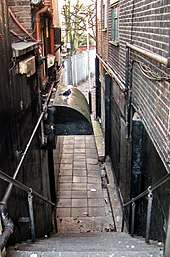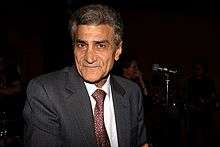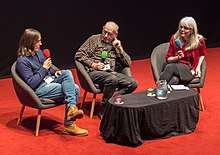Ealing Jazz Club
The Ealing Jazz Club was a music venue on The Broadway, Ealing, in the west of London. Opened in January 1959, it became London’s first regular R&B venue with a performance by the influential Alexis Korner and Cyril Davies band Blues Incorporated.

History

The Ealing Jazz Club was opened at 42A The Broadway, Ealing, in the west of London, in January 1959. The manager of the Ealing Club was Teheran-born student Fery Asgari who ran the venue for fellow students of Ealing Technical College, now part of the University of West London. Asgari had been using Ealing Town Hall, then the upstairs ballroom of The Feathers, a pub opposite the Ealing Club venue prior to taking on the Jazz Club premises where he ran jazz nights on Thursdays and Fridays, and R&B on Saturdays.[1] [2]
Situated in a basement opposite Ealing Broadway station, it was reached by descending the narrow steps of the alley that leads to Haven Place, between the tea shop and what at the time was a jewellery shop. Korner and Davies moved their previously acoustic blues club at the Roundhouse pub in Wardour Street, the London Blues and Barrelhouse Club, to Ealing on 17 March 1962 after it was ejected for going electric. The Ealing venue had been suggested to them by Blues Incorporated singer Art Wood.
Korner recalled: “The club held only 200 when you packed them all in. There were only about 100 people in all of London that were into the blues and all of them showed up at the club that first night”.[3]
The club is noteworthy as the place where, on 24 March 1962, Charlie Watts first met Brian Jones then, on 7 April 1962 Alexis Korner introduced Mick Jagger and Keith Richards to Brian Jones, and the nucleus of the Rolling Stones first came together. [4]
And it was where, nearly a year later, the classic line-up of the Rolling Stones, with Charlie Watts on drums played for the first time in public on Saturday, 12 January 1963.[5] However, it was not until an Ealing gig on 2 February 1963 that Watts became the Stones' permanent drummer. [6]
Eric Clapton has recalled that occasionally he stood in for Mick Jagger at the club when the novice Rolling Stones singer had a sore throat.[7]
The regular musicians at the Saturday night blues sessions during 1962-65 included Jack Bruce, Ginger Baker, Eric Clapton, Charlie Watts, Graham Bond, Long John Baldry, Rod Stewart, Dick Taylor, Dick Heckstall-Smith and Paul Jones. Manfred Mann (originally the Mann-Hugg Blues Brothers) also played there. The Who appeared there early on in their career, when they were known as the Detours. Eric Burdon, lead singer of the Animals and John McLaughlin also frequented the club.[8][9]
Burdon has written about hitchhiking to London from Newcastle upon Tyne to visit the Ealing Club, where he and 'tall, skinny, short-haired schoolboy' Mick Jagger were picked out of the crowd by Korner to sing together.[10]
After a visit to the Ealing Club, Harold Pendleton owner of the then-struggling Marquee Club switched its programming from jazz to R&B when he hired Korner's band for a weekly Thursday night residency from 3 May 1962.[11] [12]
Another early visitor to the club was John Mansfield who decided to set up the Ricky-Tick club in Windsor as a blues venue.
The Ealing Club also played a part in the sound of rock. A Sunday night in 1963 saw the first public performance ever to use the classic 'loud' Marshall JTM45 guitar amplifier. The band assembled to test a pre-production version of the amp included future Jimi Hendrix Experience drummer Mitch Mitchell -- who worked in the Marshall shop in Hanwell -- and saxophonist Terry Marshall, the 'T' in 'JTM'. [13]
Legacy
Since then, the venue has been operated as a casino as well as a disco under various names including Tabby's, The Nutmeg, Chequers, Madocs and Club Azur. These days, as the Red Room, the premises consist of two small bars a dance floor/performance space and a seating area which occupies the space where the stage was in the 1960s. Sometimes referred to as the Ealing Blues Club, the venue is now a nightclub called The Red Room.

In 2011, a community group of Ealing residents, musicians and music fans known as The Ealing Club initiated a campaign to bring back live music to the venue and highlight its important contribution to the development of British blues and rock. The group's first three events were held on the nights of 18–20 July 2011, with proceeds going towards the installation of the blue plaque unveiled on 17 March 2012.

Suburban Steps to Rockland, a feature film documentary about the story of the club, premiered at the Doc'n Roll Film Festival on 4 November 2017 at the Barbican Centre. The film includes interviews with many of those who played there including Jack Bruce, Ginger Baker, Don Craine, Eric Burdon, Paul Jones, Terry Marshall, John Mayall and Dick Taylor, as well as club manager Fery Asgari.[14] In 2019 Sky UK acquired broadcast rights to the film, which received its first screening on 8 September.
The nearest rail and tube station to the club is Ealing Broadway.
See also
- Ealing Jazz Festival
- List of jazz clubs
References
- The Ealing Club A-Z of Ealing Rock, Ealing Club Community Interest Company, 2019, p. 2, ISBN 978-1-78926-463-0
- "The Club Where The Who First Rocked". London: BBC News. 2001-01-01. Retrieved 2017-11-12.
- Schwartz, Roberta Freund (Nov 2007), How Britain Got the Blues: The Transmission and Reception of American Blues Style in the United Kingdom, Ashgate, p. 126, ISBN 978-0-7546-5580-0
- Wyman, Bill (2002), Rolling With The Stones, Dorling Kindersley, p. 32, ISBN 0-7513-4646-2
- Wyman, Bill (2002), Rolling With The Stones, Dorling Kindersley, p. 51, ISBN 0-7513-4646-2
- Richards, Keith (2010), Life, Weidenfeld & Nicolson, p. 121, ISBN 978-0-297-85439-5
- Clapton, Eric (2007), Eric Clapton: The Autobiography, Century, p. 46, ISBN 9781846051609
- Schwartz, Roberta (2011-08-05). "Retro West London: The Cradle is Rocking Again". Ealing Gazette. Ealing: Trinity Mirror Southern Ltd. Retrieved 2011-08-06.
- Dicaire, David (2006), Jazz Musicians, 1945 to the Present, McFarland & Co, p. 207, ISBN 978-0786420971
- Burdon, Eric (1986), I Used To Be An Animal, But I'm All Right Now, Faber & Faber, p. 34, ISBN 0-571-13492-0
- Norman, Philip (1984), The Stones, Elm Tree Books, p. 45, ISBN 0-241-11065-3
- Shapiro, Harry (2010), Jack Bruce: Composing Himself, Jawbone Press, p. 59, ISBN 978-1-906002-26-8
- "Marshall Amps – The Complete History". Bath: The Guitar Magazine. 2013-11-13. Retrieved 2011-07-25.
- "Ealing Film Reunites Blues Pioneers". London: EalingToday.co.uk. 2017-11-09. Retrieved 2011-07-25.
External links
| Wikimedia Commons has media related to Ealing Club. |